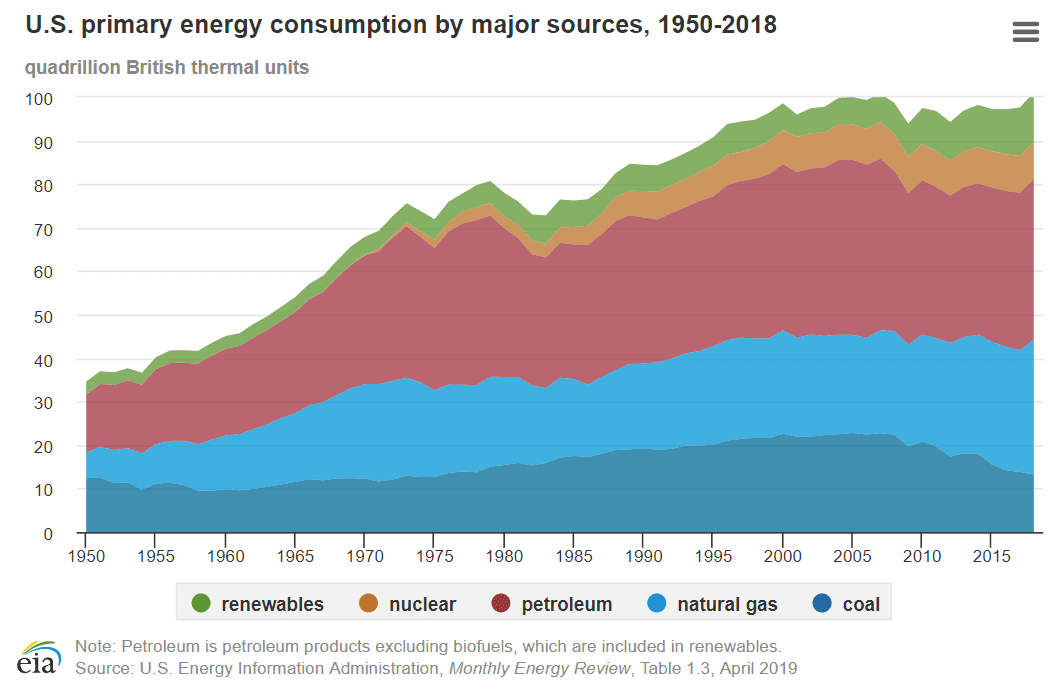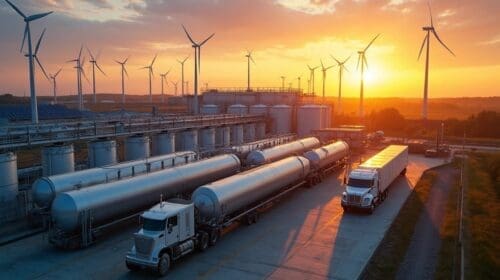In the United States, concerns arise about the leakage of methane gas into the atmosphere during oil and gas drilling operations. Some say it is a crisis, however, for any decision there are always tradeoffs, both positives and negatives, to consider. This article will analyze methane emissions vs. increased U.S. natural gas production since year 2000 and the beneficial effect that that has had in replacing coal-fired electricity generation with cleaner-burning natural gas.
First, some methane facts from the American Geosciences Institute:
- In 2015, methane made up about 10% of U.S. greenhouse gas emissions in terms of global warming potential
- Carbon dioxide (CO2 ) made up 82% of U.S. greenhouse gas emissions
- Natural gas provided 31.5% of U.S. electricity in 2017 – the largest single source of electricity in the country
- Natural gas power generation produces 50-60% less CO2 than coal to produce the same amount of energy, but methane leaks reduce this emissions-saving benefit
- EPA estimates of methane emissions from natural gas systems decreased by 16% from 1990 to 2015; methane emissions from crude oil and refined oil product systems decreased 28% from 1990 to 2015
- In addition to livestock, manure, mining, and landfills, other major sources of global methane emissions also include wetlands and rice paddies
Source: https://www.americangeosciences.org/geoscience-currents/methane-emissions-oil-and-gas-industry
The major sources of U.S. methane emissions by source are shown in Graph 1:
Graph 1: 2015 U.S. Methane Emissions By Source

Source: EPA estimates of U.S. methane emission sources in 2015
Methane itself is a more potent greenhouse gas than carbon dioxide, and methane leaks from wells, pipelines, or processing equipment can substantially increase the greenhouse gas emissions of the natural gas sector, while also wasting resources as methane escapes into the atmosphere.
According to the American Geosciences Institute, in the Barnett shale area around Dallas and Fort Worth, Texas, 67% of methane emissions are from oil and gas sources. Half of all oil and gas methane emissions in this area come from just 2% of production, processing, and transportation facilities, and 90% of emissions come from just 10% of facilities. Perhaps looking at the small percentage of locations that account for the lion’s share of methane emissions could not only be cost-effective but also reduce significant emissions and drive greater natural gas profitability.
The American Geosciences Institute also states the six major pollutants produced directly or indirectly by burning fossil fuels (in addition to other human activities) are required by law to be regulated by the EPA under the Clean Air Act: carbon monoxide (CO), nitrogen oxides (NOx), sulfur oxides (SOx) ozone (O3), particulate matter (PM), and lead (Pb). Sulfur oxides (SOx, mostly sulfur dioxide, SO2) are primarily produced by the burning of fossil fuels (especially coal) in power plants and other industrial facilities. The switch from coal to natural gas power generation since the 1980s has further cut SOx emissions. Refineries and processing plants are also required to capture sulfur from oil and gas, reducing SOx emissions upon combustion.
The oil and natural gas system is one of the most complex sources for emissions estimates because of the number of emission sources, their technical complexity, and the variability between different facilities.
Evaluating methane emissions on a global scale, Graph 2 from the International Energy Agency shows the contribution from oil & gas operations in metric tonnes of methane per year.
Graph 2: Global Methane Emissions From Oil & Gas Operations

Source: IEA https://www.iea.org/tcep/fuelsupply/methane/
Along with increased global methane emissions, we have seen increased global methane production as shown in Graph 3 from the IEA.
Graph 3: Global Methane Production 2000-2018

Source: IEA https://www.iea.org/tcep/fuelsupply/methane/
Using IEA data to evaluate the impact of methane emissions, Graph 4 compares the ratio of global methane emissions to global methane production, i.e. the downside of producing methane along with the upside from using methane. The graph shows that as global natural gas production has increased while providing cleaner-than-coal electricity, the ratio of tonnes of CO2 per unit of natural gas production has declined, having reached parity around 2010. This demonstrates the beneficial effects of natural gas on global emissions, but does not dismiss the need for still-cleaner forms of electricity generation.
Graph 4: Global Methane Emission/Production Ratio 2000-2017

Source: IEA https://www.iea.org/tcep/fuelsupply/methane/
When we focus solely on the United States, we see a decided increase in natural gas (and renewables) as an energy source expressed in quadrillion British Thermal Units (BTU) at the expense of coal-fired generation as shown by Graph 5 using the U.S. Energy Information Administration (EIA) data.
Graph 5: U.S. Primary Energy Consumption By Major Sources 1950-2018

Source: U.S. Energy Information Administration, Monthly Energy Review, Table 1.3, April 2019
Focusing solely on the coal/natural gas changes in the U.S., Graph 6 shows the U.S. coal & natural gas energy demand history for 2000-2018 depicting the declining use of coal as an energy source.
Graph 6: U.S. Coal & Natural Gas Energy Demand 2000-2018
In a 6 March 2019 Forbes magazine article by Jude Clemente, he states, “oil and gas operations account for a quarter of all U.S. methane emissions, meaning that oil and gas are just 2.5% of all U.S. greenhouse gas emissions.”
So what does all this have to do with methane emissions and the impression of a crisis in oil & gas production?
Summary Facts:
- In the U.S. in 2018, coal and natural gas contributed 3,174 million tonnes of CO2 in emissions, and including the use of petroleum, this total increases to 6,154 million tonnes of CO2.
- Without the energy contribution of natural gas, forcing reliance solely on coal for energy generation, the CO2 emissions would have climbed an incremental 3,186 million tonnes per year.
- Assuming that the U.S. natural gas production stagnated in year 2000 and remained at that level in future years with no incremental shale gas production to provide abundant and relatively-cheap natural gas supplies for electricity generation, the U.S. would have required 7.15 quadrillion more BTUs of coal-fired generation, emitting an incremental 735.88 million tonnes of CO2 to the atmosphere in 2018.
- Assuming that methane is 10% of overall U.S. greenhouse gas emissions, natural gas would contribute 615.38 million tonnes of CO2 in 2018. At 2.5% of GHG emissions per the Forbes article, the natural gas contribution would be 153.85 million tonnes of CO2 in 2018.
Summary Statements:
- By using incremental natural gas from increased shale oil & gas drilling/ production in the U.S., 120.49 million tonnes of CO2 emissions per year were averted after netting out the methane emissions as 10% of overall U.S. greenhouse gas emissions).
- Using the Forbes article estimate of 2.5% of methane emissions attributable to oil & gas production, the emissions savings from natural gas use net of the methane leakage emissions number is 582.03 million tonnes of CO2 emissions per year.
- The “price” of methane leakage (although not ideal in a perfect world) is well worth the benefits of natural gas use for U.S. electricity production at the present time.
- Do we need to find ways to reduce methane emissions in the oil & gas industry? Do we need a mixture of energy sources to satisfy the U.S. energy demand for the future? An emphatic YES to both questions.
- In the interim to an emissions-free energy source, access to abundant and relatively-cheap U.S. natural gas is helping the quest for lower emissions, and is not the culprit as some may say.
- The production of U.S. natural gas via horizontal fracking has increased the gas supply while reducing the price of natural gas to one of the lowest in the globe. This lowering of natural gas price along with its abundant supply has accelerated the closing of coal-fired electricity generators providing both a benefit to U.S. ratepayers in lower energy pricing while reducing the CO2 emissions.
Source: energycentral.com
Oil and gas operations are commonly found in remote locations far from company headquarters. Now, it's possible to monitor pump operations, collate and analyze seismic data, and track employees around the world from almost anywhere. Whether employees are in the office or in the field, the internet and related applications enable a greater multidirectional flow of information – and control – than ever before.





![Why Enhanced Geothermal Energy Could Be Your Next Smart Investment [2025 Guide]](https://b1006343.smushcdn.com/1006343/wp-content/uploads/2025/06/Why-Enhanced-Geothermal-Energy-Could-Be-Your-Next-Smart-Investment-2025-Guide-500x280.jpg?lossy=2&strip=1&webp=1)




